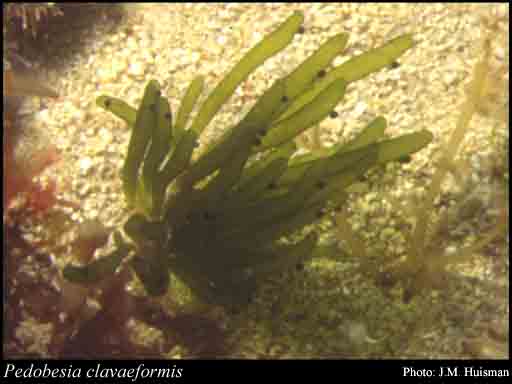- Reference
- Phycologia 92 (1974)
- Conservation Code
- Not threatened
- Naturalised Status
- Native to Western Australia
- Name Status
- Current

Scientific Description
Habit and structure. Thallus dark green, epilithic, 3–5(–6) cm high, of numerous simple, erect, clavate branches (1–)2–3 mm in diameter, arising from slender, much-branched and lobed fiIaments; chloroplasts numerous, lenticular, 2–5 µm long, without a pyrenoid but with 1–2(–3) starch plates within the chloroplast. Prostrate discs (winter state) 2–6 mm in diameter, often overgrown by secondary discs, with marginal growth and concentric rings of growth or calcification divided into radial sectors; discs coenocytic but with internal calcified pillars and calcification (aragonite) within the walls which have numerous pores.
Reproduction. By sporangia 350–450(–1000) µm in diameter, borne subapically on the clavate branches, producing stephanokontic zoospores 30–40 µm in diameter, which produce the disc stage.
Distribution. From Point Clune, Rottnest I., W. Aust., and from West Bay, Kangaroo I., S. Aust., to Cape Patterson, Vic., and Hogan I., Bass Strait, and Gordon, Tasmania. Northern New Zealand.
Habitat. Occurs in shaded pools and to 20 m deep.
[After Womersley, Mar. Benthic Fl. Southern Australia I: 292 (1984)]
Distribution
- IMCRA Regions
- Leeuwin-Naturaliste.
- Local Government Areas (LGAs)
- Cockburn, Rockingham.